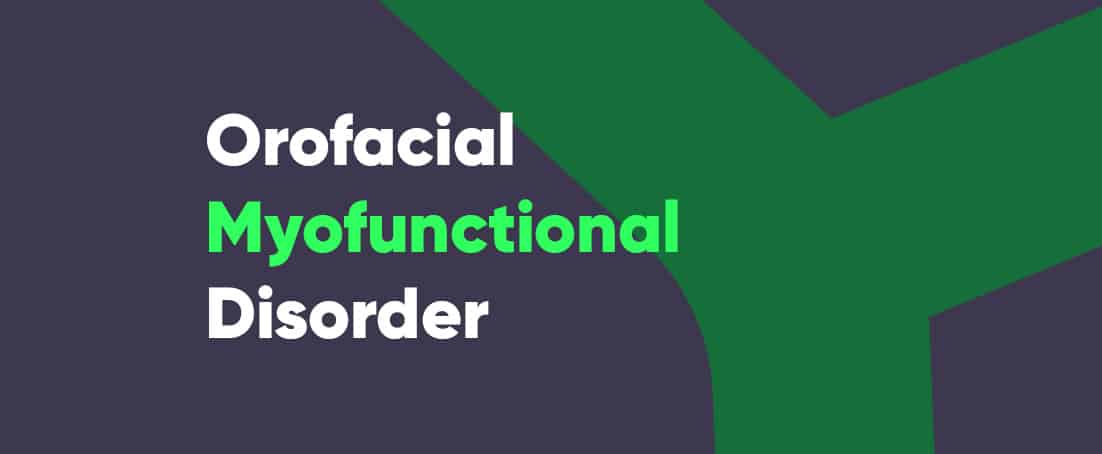Orofacial Myofunctional Disorder, or OMD, is a condition that causes an abnormal lip, jaw, or tongue posture while speaking, swallowing, or resting.
People who suffer from it can experience sleep-disordered breathing, tongue thrust, speech problems, dental abnormalities, ear infections, sinus issues, jaw and neck pain, and more.
Did you know that one in three people have OMD problems, which most often go unaddressed?
Before we dive into the specifics and treatment options for OMD, we urge you to take a quick quiz below. It’ll help you determine whether you or someone you love suffers from OMD and get a better idea of which treatment option would work best.
In this article, you’ll learn:
- 🤔 What causes orofacial myofunctional disorders
- 👩⚕️ How orofacial myofunctional disorder is diagnosed
- ✍🏻 How orofacial myofunctional disorder is treated
- 🩺 What OMD therapy is
- 🧘🏻♀️ How to prevent OMD.

What Are the Causes of OMD?
Given that the condition affects the way facial muscles are formed and used, it’s very important to understand its source before trying to remedy it:
- Genetics. OMD with a genetic origin usually stems from predetermined abnormal development in the craniofacial region. A cleft palate, deviated septum, and other syndromes can cause structural abnormalities and underdevelopment in the facial muscles.
- Thumb-Sucking and Prolonged Pacifier Use. OMD from thumb sucking or pacifier use is habitual OMD, and although not genetic, it is just as serious. It happens because these habits force the tongue to the bottom of the mouth, which can become a learned behavior after a while.
- Mouth Breathing. Breathing through the mouth instead of the nose, or mouth breathing, is another common OMD cause that can also affect the overall health of the oral cavity, teeth, and even bodily posture.Keeping the mouth open for prolonged periods of time relaxes the facial muscles and can cause orofacial myofunctional disorder. Mouth breathing during sleep (sleep apnea) can also cause OMD.
- Tongue-Tie. Tongue tie, or ankyloglossia, is a condition where the strip that connects the tongue to the mouth is shorter than usual. It is a common cause of OMD and is usually resolved surgically.For a medical professional to diagnose tongue tie, they must look into the patient’s oral range of motion. The tongue and jaw usually dissociate at the 5-6-month mark, which can be delayed in the case of tongue tie.
- Neurological Conditions. Neurological conditions that cause constrictions within the nerves of the facial area are another common cause of these disorders.
- Trauma or Injury. Various injuries to the face and jaw that affect the facial structure and muscles can also cause OMD, especially if not treated properly.
Orofacial Myofunctional Disorder Symptoms
Orofacial myofunctional disorders come with a variety of symptoms that can greatly affect the quality of life. Here are some of the most common symptoms of OMD:
Oral Symptoms
The first category directly affects the oral and facial muscles. Many of the oral symptoms can also be a cause of orofacial myofunctional disorders:
- Open Mouth Posture. Open mouth posture is both a symptom of and a cause of OMD. This symptom is most often seen in children, but it can occur in adults as well.
- Tongue Thrusting or Thrust Swallow. Tongue thrusting refers to pushing the tongue into the upper teeth while swallowing. Even though this swallowing pattern is normal during early childhood, it is meant to be unlearned eventually.If it persists, tongue thrust is a clear sign of OMD and can lead to the development of other symptoms like open bite, enlarged tonsils, and more.
- Difficulty With Chewing or Swallowing. Unlike tongue thrust, difficulty with chewing or swallowing can happen at any age. However, we mostly see it as a symptom in younger children and older adults.
- Abnormal Bite or Tooth Position. Deviations in the upper and lower teeth, upper front teeth, and the overall oral cavity are other symptoms of OMD and are usually tightly connected to other symptoms. Together, they affect the orofacial muscles and prevent them to function properly.
- Mouth Breathing. Mouth breathing problems as a symptom of OMD are connected to the unnatural rest posture of the tongue, improper chewing, abnormal swallowing patterns, and other unnatural oral habits. In turn, this symptom causes further deterioration of the facial structures and prevents proper growth and development of this area.Mouth breathing is directly connected to the impaired performance of nasal breathing.
Speech Symptoms
The speech symptoms of OMD are often connected to the oral symptoms and should always be treated in unison:
- Lisp or Other Speech Difficulties. Because of the improper tongue position, lisps can easily develop with OMD. Most commonly, orofacial myofunctional disorders will cause a frontal lisp or difficulty when pronouncing “z” and “s” sounds.
- Speech Sounds Nasal or Muffled. Because the tongue and jaw are in improper positions, speech may sound nasal or muffled. This issue can exist on its own or be combined with a frontal lisp.
- Difficulty With Articulation. Since OMD causes issues with the use of facial muscles, it may become difficult for the person suffering from it to pronounce different words and sounds correctly.This symptom also often goes hand-in-hand with the previous two.
- Difficulty With Clarity of Speech. The clarity of speech of a person suffering from an OMD can be compromised and is often the result of the previous symptoms combined together.
Other Symptoms
While all the previous symptoms are directly connected to the facial muscles and the oral region, these symptoms affect other areas of the head and body:
- Headaches. Headaches are an expected symptom and side effect of OMD. These headaches can often develop into migraines.
- Neck Pain. Because of the underdevelopment of the muscles in the face, the neck muscle function can also be impaired, causing the individual suffering from OMD to experience pain in that region.
- Facial Pain or Tension. Facial pain, tension, and stiffness can occur with an OMD and cause changes to speech and pronunciation.
- Fatigue. Fatigue is usually connected with the neck pain and headache symptoms and can be persistent, leading to stability issues.
6 Most Effective Treatment Options of OMD
Whether you have one or more of these symptoms, receiving the proper treatment for your OMD is crucial. Depending on the type of OMD you have, there are different treatment options available:
1. Orofacial Myofunctional Therapy
Orofacial myofunctional therapy addresses the symptoms of OMD directly. It works on the oral structures and improves their impact on swallowing patterns and the overall oral structure.
OMD therapy works by strengthening weak face muscles and helps you unlearn improper oral habits and behaviors with a success rate of 80%-90%. You can schedule an appointment with your dentist to give you more info. In general, the treatment lasts from 4 to 12 months.
2. Orthodontic Treatment
Orthodontic treatment focuses on the teeth and creating enough space within the oral cavity to allow the tongue to acquire a natural resting posture. The second focus is to fix the restricted nasal airway and allow the patient to breathe freely through the nose.
3. Speech Therapy
A speech language pathologist can help those suffering from OMD speech symptoms to relearn proper pronunciation and reactivate the muscles used when speaking. This type of therapy also helps promote a natural resting posture of the tongue and improves speech clarity.
4. Myofunctional Appliances
There are several types of myofunctional appliances that can help improve the symptoms of OMD. These appliances use the facial muscles to promote change in the teeth or dental arches, strengthening them along the way.
5. Surgical Interventions
Surgical interventions are mostly recommended for those suffering from OMD with genetic origin. For example, people with tongue tie, deviated septum, and other abnormalities within the facial structure can benefit most from surgical procedures.
This type of therapy can also help with fixing uneven lips, hypermobile mandible, and other oral factors contributing to your OMD.
6. Breathing Retraining
Breathing retraining includes a variety of breathing exercises that help the person get used to new breathing patterns. This type of treatment works well in fixing mouth breathing as both a symptom and cause of OMD.
It’s important to note that the success of this type of therapy depends on the severity of the issue, age, and other similar factors.
How Is Orofacial Myofunctional Disorder Diagnosed?
The doctor can diagnose your OMD using various methods:
- Clinical Examination
Clinical examination by a trained professional is one of the most important steps in understanding your OMD and recognizing it. If you suspect you suffer from a form of OMD, book a consultation with your physician and receive a proper diagnosis.
Treating OMD without understanding its cause can be ineffective in the long run.
- Medical History
If someone in your family suffers from OMD due to genetics, chances are other members of the family have it, too. Medical issues like strokes, sinus infections, and injuries in the area should also be considered.
- Assessment of Speech and Swallowing
Having your speech patterns and swallowing patterns assessed can help you recognize your OMD. This is a process that should be done by a medical professional.
- Orofacial Myofunctional Evaluation
Orofacial myofunctional evaluation will consider everything that may contribute to an OMD and recognize it as such. This process will focus on the muscle function and the activity of those muscles to determine whether OMD is present.
- Diagnostic Tools
Diagnostic tools, like our quiz, can also be effective in helping to recognize the presence of OMD. However, it is important to mention that these tools should be paired with proper medical assessment.
How to Prevent OMD
Mewing is one technique that can help you strengthen your facial muscles and relearn a proper posture. Understanding mewing is easy, especially if you use a Mewing.coach app to guide you.
The technique consists of a variety of tongue exercises that can help with tongue thrust swallow, uneven jawline and lips, mouth breathing, low tongue posture, and more.
Other effective ways to prevent OMD and promote proper muscle function are:
- Face yoga (The face yoga benefits are abundant)
- Avoiding thumb-sucking and pacifiers
- Nose breathing.
Orofacial Myofascial Disorders: Final Thoughts
If you suspect you are suffering from an OMD, we recommend talking to a physician and taking our quiz. Once you understand the origin of your symptoms, you can take direct action to fix them.
We also urge you to try mewing as well as face yoga to ensure OMD prevention and promote strong facial muscles and proper tongue posture.



